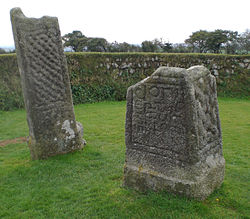- King Doniert's Stone
-
King Doniert's Stone consists of two pieces of a decorated 9th century cross. The inscription is believed to commemorate Dungarth, King of Cornwall who died around 875.
The site consists of the remains of two late 9th century granite cross-shaft fragments and an underground passage and chamber.[1] The northern cross, termed the "Doniert Stone" is 1.37 metres high with panels of decoration on three sides and the inscription "doniert rogavit pro anima".[1] The inscription translates as "Doniert has asked [for this to be made] for his soul[’s sake’]".[2] The inscription is thought to refer to the local ruler "Dumgarth" (or "Dwingarth") who is recorded in the early Welsh chronicle known as the Annales Cambriae, as having drowned in around 875 AD.[1][2] It has a mortise slot and a plinth at the base.[1]
The southern cross, sometimes referred to as the "Other Half Stone", is 2.1 metres high with a panel of interlace decoration on the east face, a broken mortise slot at the top and a plinth at the bottom.[1]
The underground rock-cut chamber begins as a passage about 8 metres to the south east of the crosses, turns into a tunnel and ends as a cruciform chamber beneath the crosses.[1] The relationship between the underground chamber and the crosses is unknown.[2]
The site is managed by the Cornwall Heritage Trust on behalf of English Heritage.[3]
References
- ^ a b c d e f Scheduled Monument description quoted in Pastscape
- ^ a b c History and research on King Doniert's Stone: English Heritage
- ^ Sites Managed and Cared for by Cornwall Heritage Trust for English Heritage
External Links
Coordinates: 50°29′34.1″N 4°29′17.2″W / 50.492806°N 4.488111°W
Anglo-Saxon Bewcastle Cross · Crowle Stone · Dartmoor crosses · Easby Cross · Gosforth Cross · Legg's cross · Ruthwell Cross · Sandbach Crosses · Sheffield CrossIrish Ardboe High Cross · several at Clonmacnoise · Iona Abbey · Kildalton Cross · Muiredach's High Cross · St. Tola's Cross · several at TuamPictish Camus Cross · Dupplin CrossCornish King Doniert's StoneCategories:- Archaeological sites in Cornwall
- English Heritage sites in Cornwall
- High crosses
- History of Cornwall
- Monuments and memorials in Cornwall
- Sub-Roman Britain
- Monumental crosses in the United Kingdom
- Cornwall building and structure stubs
Wikimedia Foundation. 2010.

